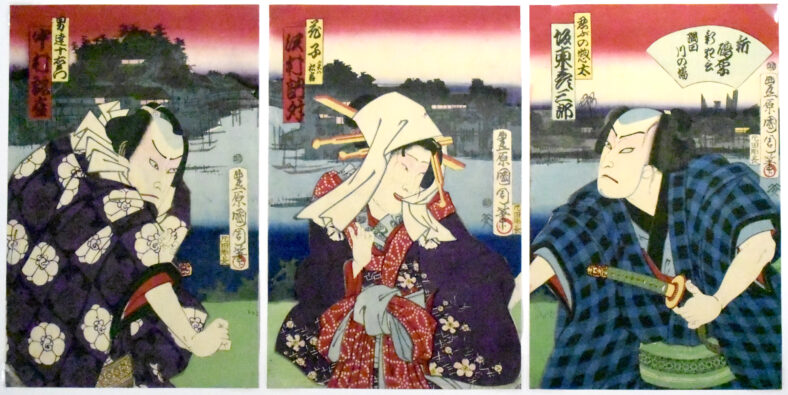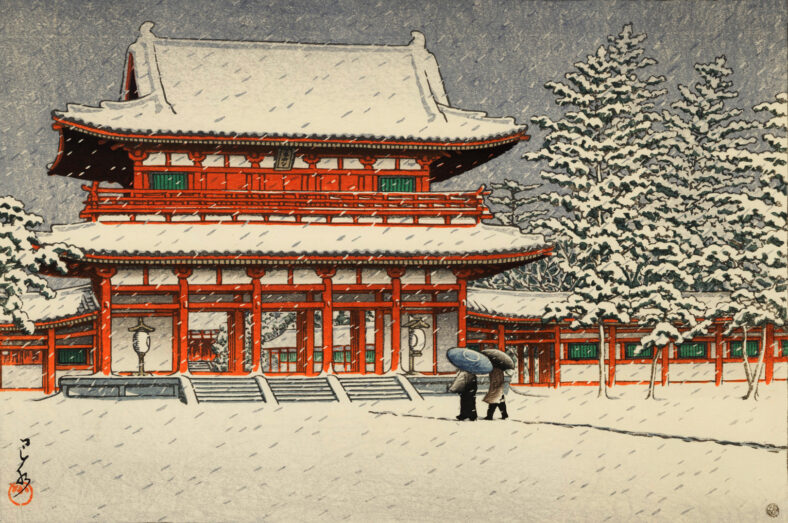From November 20, 2021 – January 30, 2022, Portland Japanese Garden will be hosting it’s final art exhibition of the year, “Ukiyo-e to Shin Hanga: Changing Tastes in Japanese Woodblock Prints.”
“Ukiyo-e to Shin Hanga: Changing Tastes in Japanese Woodblock Prints” features a selection of Japanese woodblock prints from the diverse collection of Irwin Lavenberg and illuminates the dramatic social, political and economic shifts in Japanese culture between the mid-19th and early 20th centuries through a close look at two artists: Toyohara Kunichika (1835-1900) and Kawase Hasui (1883-1957) whose work straddles the dramatic transition Japan underwent during that time.
Commercially produced woodblock ukiyo-e, “pictures of the floating world,” were immensely popular during the Edo period (1615-1868) through the first half of the Meiji period (1868-1912). Their depictions of glamorous women, thrilling theater, legendary heroes, and “scenic views” of famous places were offered to eager buyers at affordable prices as souvenirs, collectibles and temptations to partake in the pleasures of life.
In Kunichika’s prints, we see a celebration of vivid Japanese storytelling through scenes from the wildly popular kabuki theater, the pleasure quarters of Edo (now, Tokyo) and the artist’s fertile imagination. He is one of the last great ukiyo-e masters, his graphic designs capturing the spirit of the age in brilliant modern colors while adhering to the traditions of past masters with exquisite rendering of costume, in all their lavish detail, and stylized portraiture.

Kunichika’s career spanned the heyday of ukiyo-e until its demise towards the end of the 19th century, as a new generation of Japanese, enamored with the realism offered by the graphic technologies of photography and color lithography saw the traditional woodblock print as old fashioned.
As Japanese demand for traditional woodblock prints declined, the innovative print publisher, Watanabe Shōzaburō (1885-1962), sought to bring it back to life. Starting in 1906, as a publisher of woodblock reproductions of ukiyo-e master works, Watanabe took ukiyo-e’s business model to create a new type of woodblock print, aptly called shin hanga, or “new prints.”
Shin hanga portrayed traditional subject matter in a contemporary manner, its artists steeped in traditional Japanese and Western artistic styles. Watanabe, who started his career working for a Japanese exporter, marketed and sold these new prints as “fine art,” made in limited editions (a Western convention) to a largely Western market. Employing master woodblock carvers and printers using the finest printing materials, Watanabe sought out artists who shared his artistic vision.
Of these artists, the most successful and prolific was Kawase Hasui, who specialized in landscape views. Hasui masterfully designed evocative images of a classical, scenic Japan while deftly incorporating Western-inspired shading and perspective to appeal to a wider audience. His stunning contemporary landscapes rarely included indications of Japan’s rapid industrialization, and instead focused on quiet scenes capturing different seasons with the occasional solitary figure in harmony with the natural world.

Hasui’s work was widely marketed for sale in the U.S. and Europe, calling attention to the unique attractions of the Japanese landscape and contributing to the revitalization of the three-hundred year old Japanese tradition of color woodblock printing.
As you wander among these prints, consider how ukiyo-e and shin hanga influenced the Western world’s growing interest in Japanese style and drive to create something akin – in art, in fashion, in design, and even in establishing Japanese gardens outside of Japan.
Learn more about Irwin Lavenberg here.
To learn more about Toyohara Kunichika and Kawase Hasui, please see here.
Courtesy of the Irwin Lavenberg Collection of Japanese Prints
Exhibition Consultant: Lynn Katsumoto
For a behind-the-scenes tour, please see here: